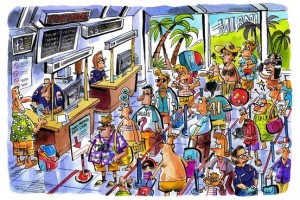Some of you know that we have a kid serving in the Peace Corps in Morocco. You might also know that we went to visit him last week – took him to Spain for a little bit of a vacation along the Costa Del Sol – some castles, boardwalks, Spanish food, beer, and so on. It was a fantastic (if short!) vacation, but it led me to an insight about marketing.

Are daunting processes messing up your sales numbers?
We traveled from Morocco to Spain and back by ferry, which looked pretty easy when you’re at home, planning the trip, looking at Google Earth on your computer screen. It’s quite a different thing in reality.
The most frustrating part of the trip was probably the customs lines at the Tanger ferry terminal. I wish I’d taken pictures, but I thought I’d lose my camera (and/or my spot in line) if I tried it.
The frustrating part was this: Every single person had to go through the same line, whether they were traveling with just a backpack; or with a carload of boxes, bags and bundles purchased in Spain. Some people had three or four baggage carts with clothing, appliances, furniture, and so on.
We were trudging through a maze of stanchions, as the folks in front of and behind us pushed, dragged, trundled or rolled their stuff toward the x-ray machines. The good news is that everyone was helpful – we all helped one another progress through the line. About an hour later, when we arrived at the x-ray machines, we had all made some new friends, and everybody was carrying somebody else’s stuff. The poor guy sitting in front of the monitor (one guy for four machines, as near as I could tell) had no way of knowing whose stuff was whose, and had no way of stopping anyone from just picking up their stuff and walking off with it after it emerged from the conveyer belt.
This could have been massively helped by having two lines, as most customs departments do – one line for travelers with merchandise, another for travelers with “nothing to declare.”
And that wasn’t the only example – we should not have been surprised since our first experience in the country of Morocco was to wait for about two and a half hours at the airport passport control upon arriving in Casablanca from Paris.
Security theater, at its best. As someone who has complained about the TSA in the US, I have to say, the TSA upon our return to New York were weirdly refreshing by comparison.
So, the point of all this is that word gets around.
Mickey and John enjoying a well-deserved coffee. Of course we were motivated to take the ferry, regardless of inconvenience. The things one does to spend time with ones’ kids! Less motivated tourists might get word of a daunting experience and skip it altogether.
Although Morocco is only 2.5 hours away from Spain by ferry, it’s a world apart in terms of tourism revenue. (Spain earned almost seven and a half times the tourism revenue that Morocco earned from 2009 to 2012, according to the World Bank.)
How much of that tourism is lost because of inefficient processes? It’s hard to say. But given the enchanting history, art, literature and heritage of Morocco, and it’s proximity to Spain, I was puzzled before our trip that so few of our well-traveled friends have been there. How many of your sales are being lost to inefficient processes? No matter how attractive your product, there are people who will hesitate to purchase, and will hesitate to recommend it to others, if the process of acquiring, installing, using it or getting customer service for it is perceived as daunting. People use aviation products and services for one primary reason- convenience. Private aviation is the ultimate “time machine,” allowing them to be where they want to be with a minimum of time and effort. Customers, particularly affluent customers, are increasingly intolerant of inconvenience. I’m sure tourism companies, hotels and resorts in Morocco will say – “But that’s outside of our control! We don’t set passport control or customs policy.” Many aviation companies react in the same way – there are many regulatory factors outside our control that can make things difficult for our customers. But there is always SOMETHING we can do, and smart aviation companies seek to expand their influence to make things easier for their customers:- NBAA actively lobbies for less cumbersome and prohibitive regulation, like user fees and excessive searches. Every roadblock and expense they remove or prevent helps many aviation companies.
- AeroStar Training Services provides ab-initio (from the first flight lesson through the airline type rating) options that include room and board and coordinate with colleges and universities to provide an all-inclusive flight training options for airlines and self-funded students. This makes the process less daunting for companies that can find the right candidates and trust AeroStar to take care of the details.
- Dallas Jet International has relationships with attorneys, accountants, tax experts and other professionals to make the sale or acquisition of a business jet as seamless as possible for their clients. This helps their clients learn from the experience and expertise of a diverse team of specialists so they don’t run into a preventable snag or miss an important advantage.
- Tanis Aircraft Products acquires STCs for many of their products, and provides Weather Safety Tips above and beyond the use of their products. This helps their customers fly confidently in cold weather.
- The Taj Hotel in Bangalore (not an aviation example, but travel-related) sent a facilitator to pick us up at the airport, assist with the customs process, translate for us if needed. He also took us back to the airport and facilitated our departure. This was a huge help on our first (daunting) trip to India.
What you can do:
- Make a list of the (real or perceived) problems or issues your customers run into before, during or after making a purchase from you. Include weather, regulatory, and other factors “beyond your control.”
- Brainstorm ideas of how your company might provide information or services to prevent those problems.
- Perform a cost-benefit analysis for the best ideas – how many more sales would you have to make to cover the cost of providing solutions?
- Implement solutions that make sense.
- Measure and re-evaluate your efforts annually. If it works and it’s cost-effective, consider doing more!
So, we’re back.
PS – Don’t let this post discourage you from visiting Morocco if you’re so inclined. The people are warm, open and welcoming, and there are a lot of things well worth seeing. We visited large cities and remote areas, and never once felt unwelcome or unsafe, as somewhat “obvious” Americans. A little more French on our side would have been helpful. (I once got eggs when I thought I had ordered salad.) Altogether, trip is well worth the wait.
Even if you don’t have kids there!}..
